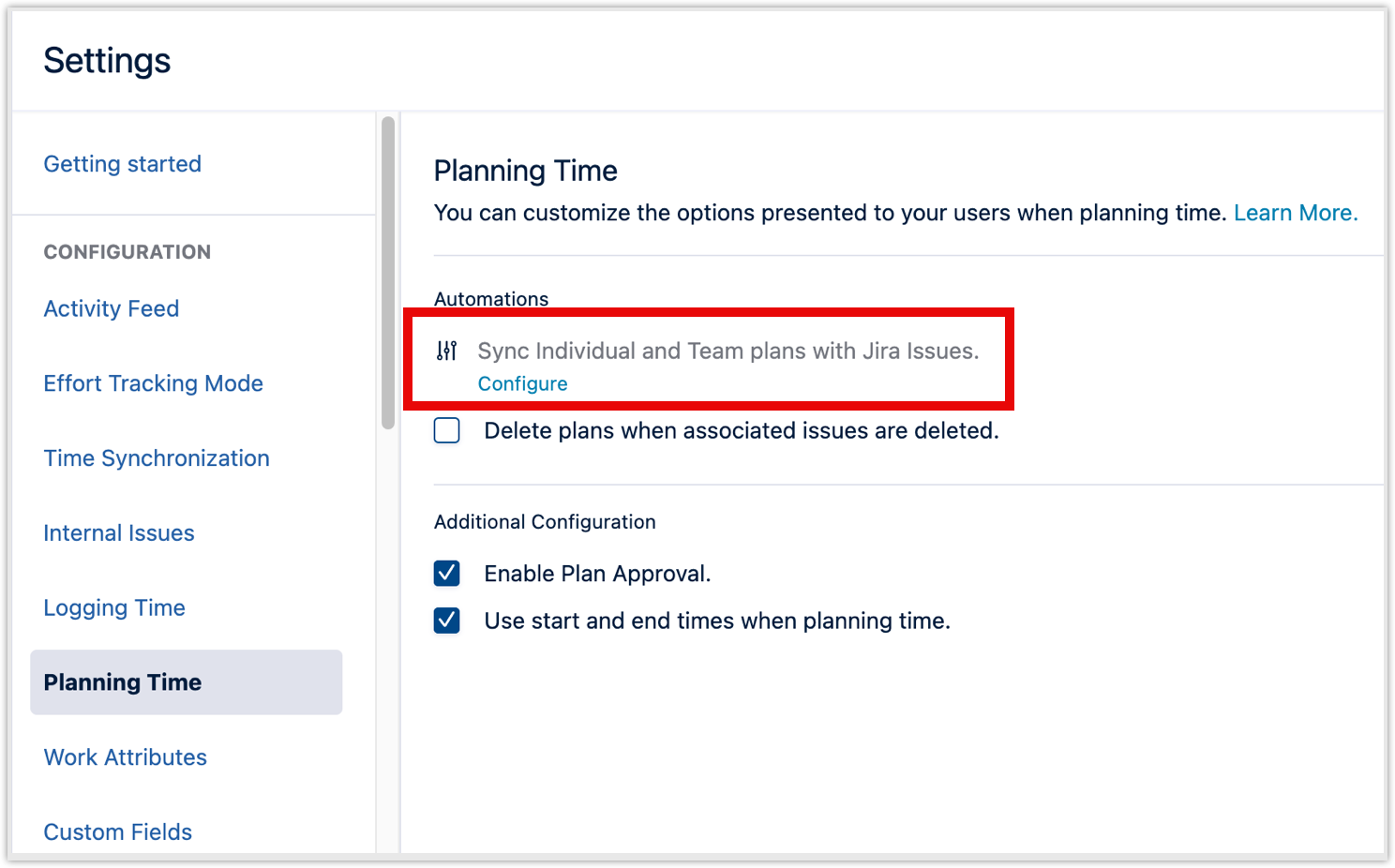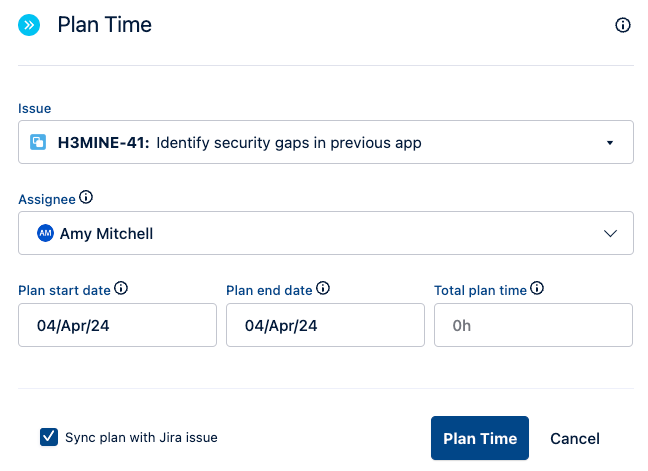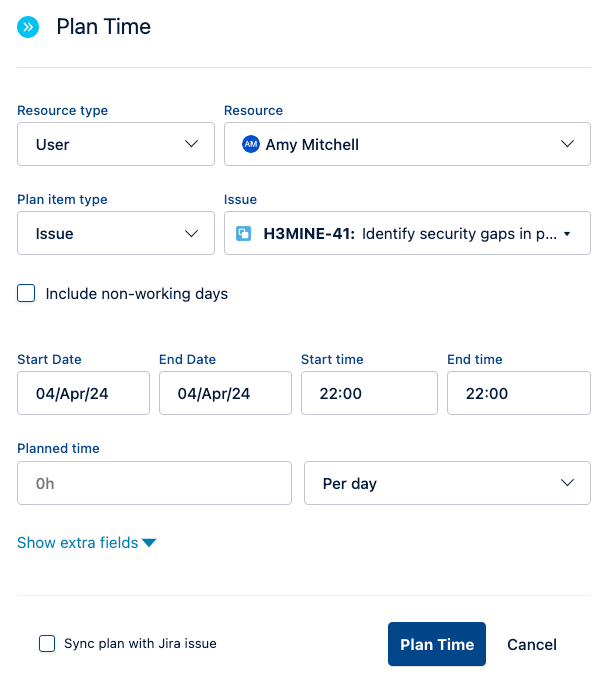Enabling this feature automatically disables creating plans by importing Jira issues.
This feature requires you to have the Edit Issues permission in your Jira project to configure issue fields.
Note: The ability to edit a synced plan respects the Edit Issue permission in Jira. A user can edit a synced plan if they are allowed to change the issue. In this case, the Tempo Team "Manage plans" permission is not required.
The Sync Plans with Jira Issues option provides a two-way sync between Tempo Capacity Planner and Jira.
When enabled, creating new issues in Jira can automatically create new Tempo plans; changing synced Tempo plans will update their related Jira issues, and changing Jira issues will update Tempo plans.

Any issues with a “Done” status (Closed, Resolved, etc.) will not be synced with Capacity Planner when Sync Plans with Jira Issues is enabled. For example:
-
If an issue is Closed and you subsequently enable Sync Plans with Jira Issues, the Closed issue will not be synced. It must be reopened to sync.
-
If Sync Plans with Jira Issues is enabled and a synced issue is transitioned to Closed, any issue fields that are subsequently modified will not be synced.
Synced Data
When enabling Sync Plans with Jira Issues, you must tell Planner which Jira fields represent the following Tempo attributes for plans:
-
Plan start date
-
Plan end date
-
Total planned time
-
Assignee
These fields remain synced between Tempo and Jira.
For Team plans, the Assignee field must be a Tempo Team. Add the Tempo Team custom field to Jira to keep Team plans synced.
Selecting Jira fields
When choosing which Jira fields are used to sync with Tempo plans, be aware that:
-
The field data types must match. You must select a date field in Jira to sync with a date attribute in Planner.
If you try to sync a plan and encounter an error, verify that the fields listed in the Sync drop-downs for Capacity Planner are the same fields you have configured in the issue view for your Jira project. For example, if you have Start Date, Due Date, Original Estimate, and Assignee fields configured in the Sync drop-down, these same fields should match in the Jira issue view. You can configure the fields for the Jira issue view by selecting Configure at the bottom of the Fields panel or in Project settings>Issue Layout.
-
We recommend using the default, Original Estimate, Jira field for Total planned time in Tempo. If you want to use a different field, select a
numberfield to sync.-
We do not recommend using the Remaining estimate Jira field because it changes frequently when logging time and due to Jira’s limitations in dealing with automatic updates when the field is changed due to logging time to the issue.
-
When syncing this data between Jira and Capacity Planner, the time unit for the data is displayed in seconds on the Jira issue. The Total planned time in Tempo is displayed in hours. When entering data in the selected
numberfield in Jira, you must enter at least60to see time in the Total planned time field.
-
Plan Time Anywhere
Enabling Sync Plans with Jira makes Tempo plan data available outside of Planner. Planned time can now be viewed directly from Jira and from any app that utilizes Jira fields—if the fields selected above are available in the app, then plan data is available.
Automatically Creating Plans from New Jira Issues
If Sync Plans with Jira Issues is enabled, when a new Jira issue is created, a new Tempo plan will also be created if the four fields selected for plan start date, plan end date, total planned time, and assignee are filled in.
Creating Plans from Existing Issues
If you’re enabling Sync Plans with Jira Issues for the first time, chances are you already have existing Jira issues. New plans will not be created automatically for these existing issues.
To create synced plans for issues created before Sync Plans with Jira Issues was enabled, do one of the following:
-
Create new plans for each issue in Planner.
-
If an issue is missing any of the synced fields listed above, add data to those fields - once there is data in all synced fields, a plan will automatically be created.
-
If all synced fields already have data, temporarily remove the data from a field, and then add it again.
Synced vs. Not Synced
When Sync Plans with Jira is enabled, users will see a simplified planning screen for synced plans. Once an issue is selected, the remaining fields will automatically be populated based on the existing values in Jira. If any values are missing, they must be filled in before saving the plan.

When plans are synced with Jira:
-
Any changes made to the plan values in Jira or Planner will be synced with both automatically
-
Only one synced plan allocation can be made per Jira issue. Issues can have additional, unsynced plans.
-
Plans can only be created for issues
-
Plans can only be created for Jira users
-
Synced plans cannot be recurring plans
-
Synced plans cannot be deleted directly from the Planner screen - the plan will be automatically deleted if the issue is deleted or if one of the synced fields on the issue is changed to blank/no value.
Planning without sync
Users can also access the classic planning screen by clearing the “Sync this plan with Jira issue” option.

When plans are not synced with Jira:
-
Many plan allocations can be made for a single Jira issue
-
Plans can be created for issues or projects
-
Plans can be created for generic resources or Jira users
-
Changes made in Planner will not update Jira
